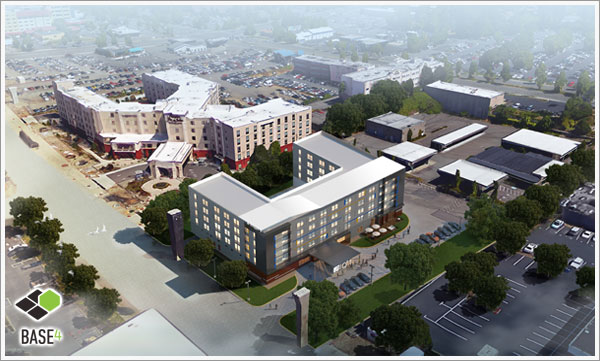The bottom line question hotel developers are asking right now regarding sustainability; “Is there an ROI on this sustainable design decision that I can recognize without sacrificing the guest experience?”
With the celebration of Earth day two weeks ago, sustainability is at the forefront of design dialogue. Recently, I was asked by HotelNewsNow to give my thoughts on this topic. (The full article can be found here.) RevPAR and occupancy numbers are very strong right now, but land and construction prices are also on the rise. Because of this, we’ve seen that most developers are less worried about a LEED certified plaque and more interested in making design decisions that are good for the environment and their bottom line.
One good example of this would be LED lighting. Five years ago, very few of the hotels we designed included LED lighting because of the initial upfront cost. However, technology has made considerable gains driving the cost down. In 2014, 90%+ of our hospitality projects took advantage of LED lighting. LEDs are a good fit for the hospitality sector as they reduce energy consumption, maintenance, and overall cooling costs of the building. Most owners are seeing an increased upfront cost for this, but on a typical prototypical hotel this increase can usually be recognized in 15-18 months of operation. After opening, owners could see as high as a $50,000-$60,000 per year savings on their utility costs which makes this sustainable decision a no-brainer.
Another example of these types of technologies would be intelligent energy management systems like Telkonet’s EcoSmart, product. Typical ‘occupied’ hotel rooms are vacant 70% of the day. A considerable amount of energy is wasted heating, cooling, and supplying power to rooms during this vacant time. Systems like EcoSmart allow guests to control temperature while in the room, however, when the room is unoccupied it allows the temperature to drift for energy savings and then return to the occupant selected setpoint within a predefined number of minutes when the occupant returns. The key is reducing operating costs without sacrificing the expected guest experience. Instituting systems like EcoSmart can save 20-45% on energy consumption without sacrificing guest comfort. A 10% reduction in energy cost is equivalent to increasing ADR by 2.6% and occupancy rates by 4.3%. These are numbers that relate very well to hotel developers and as the technology of these systems continually gets better, these numbers will only improve.
 In general, most travelers like the idea of LEED hotels, but do not want to pay a premium for them. Since rates likely can’t be increased, cost saving must be realized in other operational areas for this to make good business sense. Sustainable development will continue to grow in our industry as long as the technology continues to make sustainable elements easier and cheaper to instate.
In general, most travelers like the idea of LEED hotels, but do not want to pay a premium for them. Since rates likely can’t be increased, cost saving must be realized in other operational areas for this to make good business sense. Sustainable development will continue to grow in our industry as long as the technology continues to make sustainable elements easier and cheaper to instate.
We are excited to be a part of these new sustainable trends and look forward to assisting our clients in the design of some of these elements. If you have any questions about the benefits or challenges of sustainable design please contact our office.






